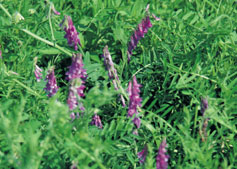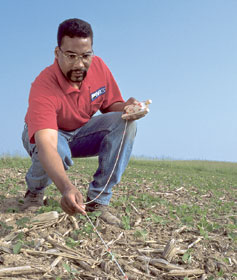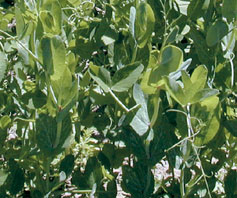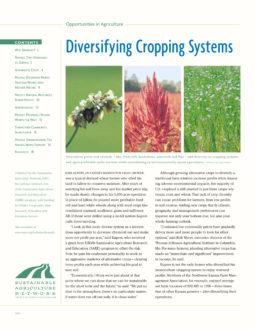Cover Crop Use and Management

Planting cover crops between cash crops provides a great opportunity for farmers and ranchers to diversify. In addition to improving soil quality, cover crops slow runoff, crowd out weeds, prevent nitrogen leaching, provide habitat for wildlife and beneficial organisms, and can even be grazed or harvested.
“Preventing erosion is perhaps the most obvious soil benefit of cover crops,” said Marianne Sarrantonio, a professor of sustainable crop production at the University of Maine, “but providing organic matter is a more long-term and equally important goal.” For more information about cover crops, see Managing Cover Crops Profitably, 3rd Edition.
Most farmers plant annual grasses or legumes as covers, sowing winter annuals in late summer or early fall to provide cover until the following spring. The grasses scavenge nitrogen and prevent its loss while the legumes add nitrogen to the system; mixing grasses and legumes optimizes rapid soil cover and overall soil improvement.
Although any fast-growing herbaceous plant has potential as a cover crop, seed cost or availability can be limiting. Other challenges include selecting a cover crop that will survive the winter, finding a method of low-cost seeding and developing an efficient way to kill or control the cover before planting the primary economic crop. Some tips for successful cover cropping include:
- Choose covers that are easy to plant and establish and also easy – and affordable – to kill and control.
- Satisfactory varieties should provide reliable and persistent ground cover and have no negative impact on the following economic crop – such as using up too much soil moisture or harboring pests.
- When selecting a legume, make sure it has good ability to provide nitrogen.
- To boost biomass accumulation or improve winter survival, some producers seed a cover crop before the previous cash crop has finished growing. You can overseed a cover crop with a planter early in the growth cycle of a select few crops – such as clover into wheat – and you can seed some other covers during the last cultivation.
- For appropriate crops in your region, consult Managing Cover Crops Profitably, 2nd Edition (see “Resources").
Because killing or controlling cover crops is a key management consideration, many farmers favor spring oats for their ability to die reliably during cold winters. However, the longer a cover crop survives into the spring, the longer it curbs erosion or traps moisture, so other farmers select a cover that must be killed with herbicide or tilled in before they plant their summer cash crop. In Lancaster County, Pa., Steve Groff rolls down his jungle-like cover-crop mixtures of hairy vetch, rye and crimson clover with a Buffalo rolling stalk chopper before transplanting tomatoes into those 25 acres.
Some farmers prefer to suppress, rather than kill, the cover crop while the cash crop is getting established, then let the ground cover grow gradually as an understory crop. White Dutch clover, for example, provides erosion control, weed suppression, supplemental nitrogen and possible habitat for beneficial insects. This can only be done successfully with ample moisture. Don’t jeopardize a cash crop by allowing the intercrop to compete for available soil moisture!
Rotational Benefits
Whether farmers rotate their crops primarily for economic or environmental reasons, agro-ecosystems clearly benefit from a diversity of crops. Rotational crops curb erosion, improve soil structure, conserve soil moisture and help break up insect, disease and weed cycles. They also contribute soil nutrients: small-seeded legumes like alfalfa or sweet clover are an economically competitive nitrogen source with commercial fertilizer.
In the long-term Wisconsin Integrated Cropping Systems Trial, launched in 1989, soybeans benefited from the so-called “positive rotation effect” when small grains were added to a traditional corn-soybean rotation. While the corn seemed to need only soybeans to maximize its performance, reduced disease pressure in the longer rotation bumped up soybean yields. Altogether, the expanded rotation returned $43 more per acre, on average, than the original rotation – and its income was more stable. The research was funded in part by a SARE grant. The randomized, replicated studies were conducted on two research farms – in Dane and Walworth counties – representing different climates and soil types.
In southeastern Minnesota, grower Andy Hart, using a SARE grant, provided $7-an-acre incentives to neighbors who wanted to try cover crops of oats, barley or winter rye after harvesting their peas and sweet corn. With most of southeastern Minnesota’s 35,000 acres of peas and sweet corn left open to wind and water erosion for up to 10 months each year, Hart was determined to find—and encourage planting of—a better rotation.
Not only did the participating neighbors continue using cover crops, but other farmers in the area began adopting the practice as well. “They see the advantage of cover crops,” said Hart. So does Lakeside Foods, a local canning company that is encouraging their use among growers.
Soil Benefits

Diverse rotations improve soil and, thus, crop yields. Rotations that keep crops or their residues in the ground longer provide more protection from wind and water erosion. Fields planted in small grains or hay are less vulnerable to erosion than those planted in row crops.
You can enhance the beneficial effects if you also reduce tillage. Surface residue moderates soil temperature and conserves soil moisture. Residue also builds more soil organic matter, which improves water-holding capacity and boosts populations of beneficial soil microorganisms. On the other hand, excessive tillage promotes erosion, dries soils and destroys soil structure as well as the food sources on which soil organisms depend.
In an Ohio State University study, a three-year reduced-tillage rotation of corn-soybean-wheat-hairy vetch compared favorably with the typical two-year corn-soybean system. Both were superior to the corn monoculture system, resulting in less soil erosion, less nitrate pollution and a better distribution of labor. The use of hairy vetch contributed at least 25 pounds of nitrogen per acre to the subsequent corn crop. The benefits of the three-year system can be attributed to a combination of factors, including greater diversity of crops, soil-building cover crops and small grains, and reduced tillage.
Farmers can use reduced-tillage practices in many rotational strategies. Excessive tillage promotes erosion, dries soils and destroys soil structure as well as the food sources and micro-niches on which beneficial soil organisms depend. Reduced tillage slows the turnover of nutrients, encourages diverse communities of beneficial insects and leaves temperature- and moisture-moderating quantities of crop residues on surfaces.
In Springerton, Ill., Ralph Upton received a SARE grant to test cover crops in his corn-soybean-wheat rotation. He wanted to learn whether cover crops like buckwheat, hairy vetch, rye, rye grass and sunnhemp would penetrate his compacted soil. Results have been promising. The rye grass, into which he plants corn or soybeans, put down roots 52 inches deep. The roots of his cereal rye, into which he plants soybeans, extend 48 inches below the soil surface. Upton also has measured his hairy vetch roots at 43 inches.
Comparing his fields to a neighbor’s, he found that a probe went 10 inches into his ground compared to just 3 inches next door. The benefits extend to his crops, too.
“We’re getting great root systems,” he said. “We had corn roots down 54 inches deep where we had the cover crop and our soybeans will go down 42-43 inches.”
With crops able to pull moisture from subsoils, Upton has seen yield increases of 3 to 6 bushels per acre, and he expects more benefits to come. “I think the benefits of this project will be very good in the long run,” he said.
Pest Management

Diverse, pest-resilient fields contain rich supplies of above- and below-ground beneficial organisms. Such organisms can:
- antagonize insects and nematodes
- inhibit growth of disease organisms
- boost crops’ natural defenses
- suppress some weeds by exposing weed seeds to more predators and decomposers
- release nitrogen more slowly, giving larger-seeded crops a head start in spring
Crop diversity can lower input costs, studies show. In an Ohio State University study, average per-acre costs for herbicides and insecticides were only $20 for a corn-soybean-wheat-hairy vetch rotation, compared with $36 for a typical corn-soybean system. In Alabama, scientists found that two years of switchgrass provided equivalent root knot nematode control as continuous peanuts with nematicide. In Maryland, two years of a sorghum-sudangrass summer crop, combined with poultry litter, effectively stemmed root knot nematodes in potatoes.
For more information on the many benefits of diversification to pest management, see the SARE bulletin, A Whole-Farm Approach to Managing Pests.
Reduced Water Use
In the nation’s drier regions, many farmers use rotational strategies to conserve soil moisture or harvest a crop despite drought. Many, in fact, frequently fallow their land – leaving it idle to accumulate moisture for the following crop. In 1997, 22 percent of the nation’s wheat was grown in wheat-fallow rotations. Fallow periods, however, expose soil to wind and water erosion and organic matter loss. Moreover, a more diverse rotation can improve yields.
A long-term study at the University of Wyoming found that partially replacing fallow with Austrian winter peas improved water use efficiency, added nitrogen to the subsequent wheat crop and provided a nutritious forage for lambs. Researchers direct-seeded peas into wheat stubble in late summer. In late spring, they turned lambs out to graze the peas for three weeks, resulting in better gain – and profits. Planting peas every fourth year increased net return per acre from $7 to $13, averaged over the four years. Moreover, while summer fallow generally only saves 20 to 40 percent of precipitation, the peas used rain or snow otherwise lost to runoff and soil evaporation.
University of Wyoming researcher Jim Krall praises the potential for the winter-hardy medic Medicago rigidula. In winter annual pastures alternating with wheat, M. rigidula reseeds itself reliably in fall and has produced more than 3,700 pounds of dry matter per acre by mid-May.
Proso millet needs the least amount of water of any cereal. Shallow rooted, it doesn’t tolerate drought as much as it evades it by maturing in 60 to 90 days after planting. Its low straw-to-grain ratio also contributes to its water-use efficiency. In moisture-limited areas of the central Great Plains, winter wheat-proso-fallow rotations provide an extra cash crop every three years. The alternative oilseeds sunflower, canola and crambe – one of the richest known sources of erucic acid, used in industrial lubricants – are all feasible in dryland rotations with winter wheat in that region.
In northern Idaho, condiment mustard’s 4-foot effective rooting depth extracts more soil moisture than peas or lentils, which is helpful in low-rainfall years. All three rotation crops are very good at breaking up disease, insect and weed cycles in cereal crops, but mustard’s more plentiful residue does a better job of protecting erosion-prone winter soils: studies show it maintains greater than 50 percent surface cover, compared with 30 percent for pea and 25 percent for lentil.
Encouraging prices have prompted “steady adoption” of condiment mustard by the region’s farmers, said University of Idaho extension specialist Stephen Guy.
Water Quality
In diversified systems that border sensitive waterways, riparian buffers strips comprised of trees, shrubs and grasses intercept sediment, nutrient and pesticide runoff. Forested riparian buffers help to reduce stream bank erosion, protect water quality, enhance aquatic environments and provide wildlife habitat.
According to USDA’s Natural Resources Conservation Service (NRCS), buffer strips can remove up to 50 percent of nutrients and pesticides, up to 60 percent of certain pathogens and up to 75 percent of sediment that might otherwise leave a field.
“In some cases, installing buffers helps producers comply with environmental laws and regulations,” said Steve Carmichael, NRCS state resource conservationist in Louisiana. “It offers an effective way a producer can demonstrate concern for the environment and a commitment to good land stewardship.”
USDA offers financial and cost-share assistance to producers interested in planting and maintaining buffers through the Conservation Reserve Program and the Environmental Quality Incentives Program.
